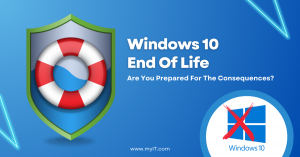 Did you know that Microsoft will end support for Windows 10 on October 14, 2025? That's just a few years away! This means that if your business relies on this operating system for its daily operations, you need to start planning now. The consequences of unpreparedness can be dire, leading to compatibility issues, security vulnerabilities, and decreased productivity. In this blog post, we will delve into what the end of life for Windows 10 means for businesses, the associated risks of being unprepared, and how partnering with a Managed Service Provider (MSP) like myIT.com can help take the worry off your plate.
Did you know that Microsoft will end support for Windows 10 on October 14, 2025? That's just a few years away! This means that if your business relies on this operating system for its daily operations, you need to start planning now. The consequences of unpreparedness can be dire, leading to compatibility issues, security vulnerabilities, and decreased productivity. In this blog post, we will delve into what the end of life for Windows 10 means for businesses, the associated risks of being unprepared, and how partnering with a Managed Service Provider (MSP) like myIT.com can help take the worry off your plate.
As the October 2025 deadline approaches, it’s crucial to understand the implications of Microsoft's decision to end support for Windows 10. This popular operating system has been the backbone of numerous businesses, supporting countless applications and processes. However, without continuous updates and support, businesses that continue to use Windows 10 face several challenges that can significantly affect their operations. The End of Life Timeline
Microsoft's typical product lifecycle includes a primary support phase followed by an extended support phase. Windows 10 launched on July 29, 2015, and has enjoyed a decade of updates, bug fixes, and security patches. However, as companies evolve their technologies and software solutions, Microsoft’s focus shifts to newer operating systems.
Key Dates to Remember:
- October 14, 2025: End of extended support for Windows 10.
- 2024: Expect fewer updates and perhaps even less compatibility with newer hardware and software.
What Happens When Support Ends?
When Microsoft stops providing updates or support for Windows 10, several challenges emerge for businesses:
- Security Risks: Cybercriminals often focus their efforts on unpatched systems after they reach end-of-life status. Without security updates, Windows 10 systems will be more susceptible to malware, ransomware, and data breaches. The stakes escalate for businesses dealing with sensitive data.
- Software Compatibility Issues: Many software vendors will likely stop supporting their applications for Windows 10 once it reaches its end of life. This means that as time progresses, critical applications—once reliable on Windows 10—may no longer function properly.
- Decreased Productivity: If your team faces connectivity issues or functionality problems with business-critical applications, it can lead to frustration and decreased productivity. Moreover, solving these issues requires time and resources—both of which are limited in today’s fast-paced work environment.
- Compliance Concerns: Organizations in regulated industries must ensure compliance with various standards like GDPR and HIPAA. Non-compliance due to outdated technology can result in substantial penalties and reputational damage.
- Increased IT Support Costs: As companies struggle to keep their outdated systems running, IT support costs may rise. Issues that arise from unsupported platforms can require more extensive troubleshooting and problem resolution.
Addressing the Challenges: Path Forward for Businesses
With support for Windows 10 coming to an end, businesses have two choices: stay on Windows 10 without support or transition to a newer operating system. It’s crucial to start planning for this transition now, as waiting until the deadline approaches can exacerbate the challenges.
Assess Your Current Environment
The first step is to assess the current IT infrastructure. Evaluate all systems and applications to determine which ones are reliant on Windows 10. Additionally, conduct a risk assessment to understand potential vulnerabilities associated with continuing to use unsupported software.
Explore Upgrades
If your business has decided to upgrade, investigate which Windows operating system will meet your needs. Microsoft has introduced Windows 11, which offers enhanced security features and a more user-friendly interface. Understand the hardware requirements, compatibility considerations, and application dependencies that come with this transition.
Implementation Plan
Once you’ve decided on the operating system, develop an implementation plan. This plan should include timelines, budget considerations, necessary hardware upgrades, and a training schedule for your team. Getting your team ready for the transition is as important as ensuring the systems work effectively. Partnering with a Managed Service Provider (MSP)
Navigating this transition can be complex, but you don’t have to do it alone. Partnering with a Managed Service Provider (MSP) like myIT.com can help streamline the process. Here’s how an MSP can be invaluable during this transition:
- Expertise and Guidance: An MSP has experience managing migrations to new operating systems, ensuring that your transition is smooth and efficient.
- Reduced Workload: By handling the planning and execution of the migration, an MSP can alleviate the burden on your internal IT team, allowing them to focus on other critical business tasks.
- Staying Ahead of Security Risks: MSPs keep up with the latest security trends and threats. By working with them, you can implement security measures that protect your organization from vulnerabilities associated with unsupported software.
- Tailored Solutions: An MSP will understand the unique requirements and challenges of your organization, allowing them to tailor a technology strategy that fits your business and meets regulatory compliance.
- Continuous Support: Instead of worrying about tech issues that arise after the transition, an MSP can provide ongoing support, ensuring all technology operates seamlessly, helping you maximize productivity post-migration.
Future-Proofing Your Business
Transitioning off Windows 10 is only the first step in future-proofing your business. As technology rapidly evolves, your organization must remain adaptable to stay ahead of the competition. Some best practices include continually monitoring your IT infrastructure, investing in employee training, and keeping an eye on industry trends.
Conclusion: Where Do We Go From Here?
As we approach the end of support for Windows 10, it’s vital for businesses to start preparing for this change now. The security and operational risks associated with using unsupported operating systems can significantly undermine your business operations. The good news is that with a proactive approach and a solid partnership with a knowledgeable MSP, you can transition smoothly into an updated environment, ensuring your organization continues to thrive.
So what changes can you make at home? Take the first step today by assessing your current systems and considering your options for future upgrades. To start the process, schedule a technology discussion with us so we can help you get a plan in place: Technology Discussion. Remember, the key to great IT management lies in preparation and adaptability. Don’t wait until it’s too late!



